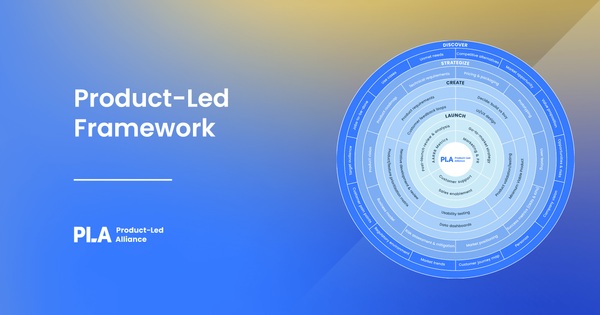Companies that adopt a product-led growth business model experience 24% faster growth rates according to a study by Gainsight. But there's a whole bunch of different concepts you need to master to satisfy your customers, motivate your team, and optimize your workflows. Enter our Product-Led Growth Framework.
The Framework covers all the areas needed to navigate the product-led journey, from start to...well, there is no finish really, is there?
For each of the four fundamental stages: discover, strategize, create, and launch, we’ve unpacked each of the cogs to arm you with all the info needed to boost your understanding of pivotal topics, as you and your team strive to create something truly memorable.
Discover
The discovery phase of the product life cycle is like laying the groundwork for a skyscraper, setting the stage for everything that follows. This pivotal phase isn't just about dipping toes into market waters; it's about diving deep to unearth invaluable insights, much like a compass guiding a ship through uncharted territories.
During this phase, teams meticulously explore customer needs, market dynamics, and potential challenges, sculpting the blueprint for innovation. It's where questions outnumber answers, but each inquiry fuels the journey toward product excellence.














Strategize
The strategize phase in the product life cycle is like plotting a road trip before hitting the open road. It's all about laying out a solid plan that sets the course for your product's journey from concept to market success.
During this phase, you're diving deep into market research, identifying your target audience, and pinpointing their needs and pain points. It's about brainstorming and validating ideas to ensure that the product you're envisioning truly resonates with potential users. Think of it as building a strong foundation – without this, the entire structure could wobble.










Create
In the Create stage, it's time to bring your vision to life. This is where the magic happens, as your ideas transform into tangible products. You'll collaborate with designers, developers, and other stakeholders to build prototypes, run tests, and iterate on your designs.
This phase is all about creativity, collaboration, and making sure your product is as user-friendly and functional as possible.










Launch
It's time for the final stage, the moment you've been waiting for: the Launch stage. This is where all your hard work finally sees the light of day as you introduce your product to the world.
You'll develop a go-to-market strategy, plan and roll out your marketing campaigns, and coordinate with sales and support teams to ensure a smooth launch. It's an exciting time, filled with anticipation and the thrill of seeing your product in the hands of users.





Spotted a few gaps you'd like to fill in?
The PLG model has shifted the way product orgs think. It emphasizes users, empowers product teams, and truly brings out the value in your product. It allows you to show, not just tell, your users that your product is the best solution.
And you - the product manager - are best positioned to own the PLG motion with your org.
Product-led Growth Certified: Core will transform you into the most-well rounded PM, enabling you to become the driving force behind your company’s PLG motion - and growth.
This framework is just the start at becoming a well-rounded PM...




 Follow us on LinkedIn
Follow us on LinkedIn





